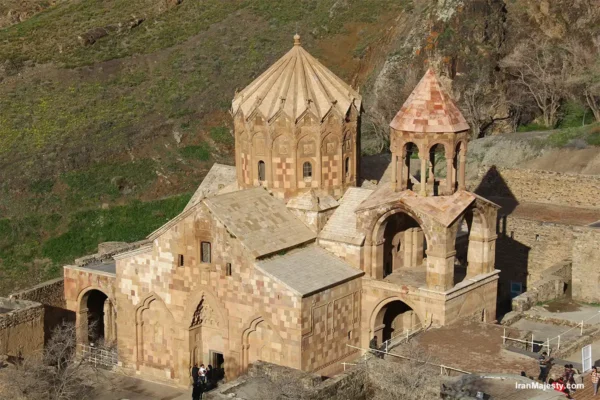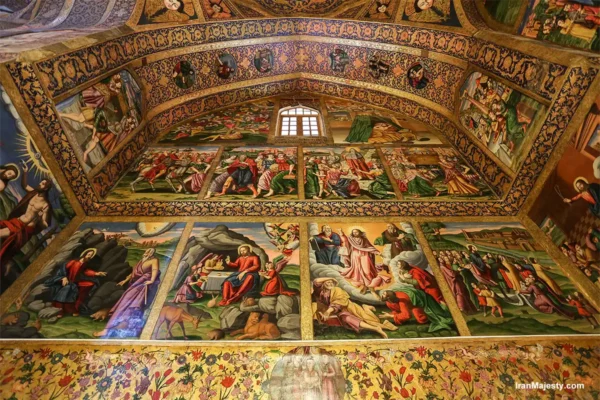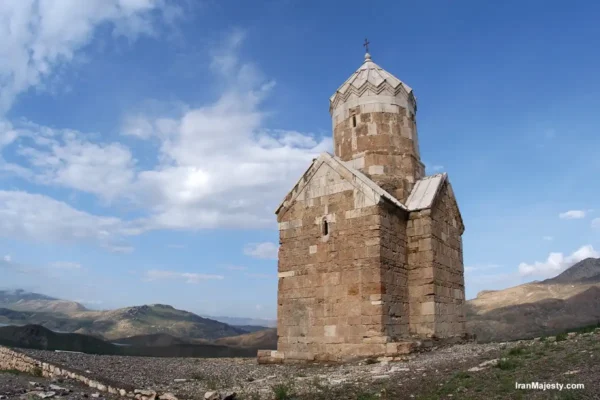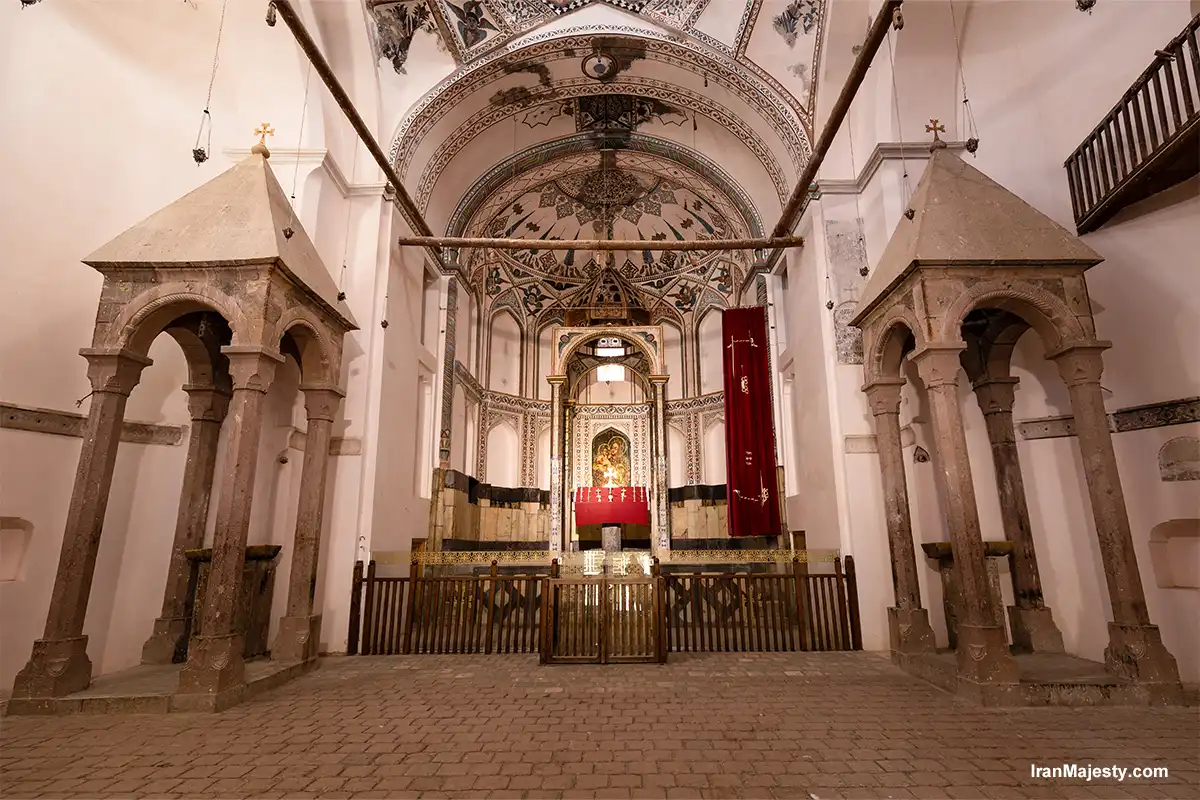When most people think of Iran, they imagine ancient Persian empires, stunning mosques, or vibrant bazaars. However, few realize that Iran is also home to some of the most remarkable churches in the world. These churches not only showcase the rich history of Christianity in the region but also highlight the cultural diversity that has existed in Iran for centuries.
Christianity has had a presence in Iran since the early centuries of the Common Era, with the Assyrians and Armenians playing a key role in spreading the faith. Today, these churches are more than just places of worship; they are symbols of harmony and cultural interaction. Walking into an Iranian church is like stepping into a space where Persian art meets Christian tradition. You’ll find frescoes, intricate carvings, and designs that blend the styles of East and West in breathtaking ways.
One striking example is the Qara Kelisa, also known as the St. Thaddeus Monastery. This UNESCO World Heritage Site is believed to be one of the oldest Christian churches in the world, dating back to the 7th century. Another treasure is Vank Cathedral in Isfahan, a masterpiece of Armenian architecture and art that draws thousands of visitors each year.
Iran’s churches are not just historical relics; they are active places of worship for communities of Christians, primarily Armenians and Assyrians, who have preserved their traditions despite challenges. Exploring these churches provides a glimpse into a lesser-known side of Iran—one that tells a story of religious tolerance, artistic brilliance, and cultural fusion.
Visiting churches in Iran is an experience that leaves a lasting impression. Their beauty, history, and spiritual significance make them unique landmarks that deserve a place on any traveler’s itinerary. Whether you are a history enthusiast, an art lover, or simply curious about the hidden corners of Iran, these churches offer something truly unforgettable.
Christianity in Iran
Christianity in Iran has a long and fascinating history that often surprises people unfamiliar with the country’s rich cultural and religious heritage. The roots of Christianity in Iran can be traced back to the early days of the faith, making it one of the oldest Christian communities in the world. Over centuries, Iranian Christians have contributed to the country’s diversity, culture, and history, forming a unique identity within the larger fabric of Iranian society.
The Early Beginnings
Christianity is believed to have arrived in Iran as early as the first century CE through the efforts of apostles like St. Thaddeus and St. Bartholomew. These early missionaries spread the faith in the Parthian Empire, which ruled over much of what is now modern Iran. By the third and fourth centuries, Christian communities flourished, particularly among Assyrian populations in the north and west.
One notable event in this period was the establishment of the Church of the East, also known as the Nestorian Church, which became a significant Christian denomination in Iran and beyond. This church developed its own theological and liturgical traditions, distinct from Western Christianity.
The Role of Armenians
The Armenian Christian community holds a special place in the story of Christianity in Iran. After Armenia became the first country in the world to adopt Christianity as its state religion in 301 CE, many Armenians migrated to Iran over the centuries. During the Safavid era (1501–1736), the Armenian population in Isfahan grew significantly, thanks to Shah Abbas I, who relocated many Armenians to the city to develop trade and crafts. Their influence is still evident today in the historic Jolfa district of Isfahan, home to the stunning Vank Cathedral.
Christian Communities Today
Modern-day Iran is home to a variety of Christian denominations, including Armenians, Assyrians, Catholics, and Protestants. The Armenian Apostolic Church is the largest and most prominent group, followed by the Assyrian Church of the East. Although Christians make up a small percentage of Iran’s population, their presence is significant, and they maintain a vibrant religious and cultural identity.
Many Christians in Iran celebrate traditional holidays such as Christmas and Easter, often adding Persian customs to their celebrations. For example, some communities decorate their churches with intricate Persian motifs, blending their faith with local artistry.
Challenges and Resilience
Throughout history, Christian communities in Iran have faced challenges, from political changes to religious restrictions. Despite this, they have shown remarkable resilience in preserving their faith and traditions. Their churches, cultural events, and historical records stand as testaments to their enduring legacy in the region.
Exploring the history of Christianity in Iran reveals a story of perseverance, adaptation, and cultural exchange. For visitors, understanding this aspect of Iran’s history adds a deeper layer of appreciation for the country’s diversity and the harmonious coexistence of different traditions.
Famous Churches in Iran
Iran is home to many stunning churches that are not only places of worship but also bear witness to the country’s architectural brilliance, cultural diversity, and historical richness. Visiting these churches offers a unique glimpse into the lives of Christian communities in Iran and their contributions to the country’s heritage. Below, we explore 10 of the most famous and awe-inspiring churches in Iran.
1. Saint Stepanos Monastery, Jolfa
Located in a lush valley near Jolfa in East Azerbaijan Province, Saint Stepanos Monastery is one of the most famous Armenian churches in Iran. This UNESCO World Heritage Site dates back to the 9th century and features exquisite stone carvings and murals. The monastery is named after Saint Stephen, the first Christian martyr, and is surrounded by breathtaking natural scenery, making it a popular pilgrimage and tourist destination.

2. Vank Cathedral, Isfahan
Situated in the Jolfa district of Isfahan, Vank Cathedral is a masterpiece of Armenian architecture blended with Persian design. Built in the 17th century, the cathedral boasts stunning frescoes, intricate tilework, and an ornate central dome. Visitors are often captivated by the church’s vibrant paintings that depict biblical stories, as well as its museum showcasing artifacts from the Armenian community’s history in Iran.

3. Saint Thaddeus Monastery, Chaldoran
Known locally as “Qara Kelisa” or the “Black Church,” Saint Thaddeus Monastery is one of the oldest churches in the world. It is located in West Azerbaijan Province near the town of Chaldoran. This UNESCO-listed site is a major pilgrimage destination for Armenian Christians, particularly during the annual feast of Saint Thaddeus. The monastery’s black and white stone exterior is both striking and symbolic.

4. Church of the Virgin Mary, Tehran
Nestled in the bustling capital of Tehran, the Church of the Virgin Mary is a serene oasis for worshippers. This Armenian Apostolic church was built in the early 20th century and is known for its modest yet elegant design. The church serves as a cultural hub for the Armenian community in Tehran, hosting religious ceremonies and cultural events.
5. Saint Mary Church, Tabriz
Saint Mary Church in Tabriz is another historic Armenian church that holds significant religious and architectural value. Built in the 12th century and later renovated, the church features a simple yet timeless design. It is believed to have been visited by Marco Polo during his travels in the 13th century.
6. Saint Sarkis Cathedral, Tehran
Located in the heart of Tehran, Saint Sarkis Cathedral is one of the largest Armenian churches in Iran. Built in the 1970s, it features modern architectural elements combined with traditional Armenian motifs. The cathedral is not only a place of worship but also a gathering spot for the Armenian community in the capital.
7. Zor Zor Church, Makou
The Zor Zor Church, also in West Azerbaijan Province, is a small yet historically significant church. What makes this church unique is its relocation in 1987 to protect it from flooding caused by a dam project. The original stones were meticulously transported and reassembled at its new site, preserving its historical integrity.

8. Saint George Church, Isfahan
Located in Isfahan’s Armenian quarter, Saint George Church is a lesser-known gem. This 17th-century church showcases beautiful frescoes and a peaceful courtyard. While smaller than Vank Cathedral, it is equally charming and holds deep spiritual importance for the local community.
9. Chaldean Catholic Church, Urmia
Urmia, a city with a long history of Christian presence, is home to the Chaldean Catholic Church. This church reflects the faith and culture of Assyrian Christians in Iran. Its architecture is simple yet dignified, offering a quiet space for worship and reflection.
10. Saint Peter Church, Shiraz
Shiraz, known for its gardens and poetry, is also home to Saint Peter Church. This small yet vibrant church is a testament to the Christian community’s resilience in a predominantly Muslim region. Visitors often find the contrast between the church’s simplicity and Shiraz’s grandeur intriguing.
Why Visit These Churches?
Each of these churches offers more than just a place to pray—they tell stories of faith, resilience, and cultural exchange. Exploring them provides a deeper understanding of Iran’s multi-layered history and the harmonious coexistence of different religions. Whether you’re drawn to their architectural beauty, spiritual significance, or historical importance, these churches are truly treasures worth discovering.
“Here’s an engaging video by Iran vibes on Churches in Iran: A Journey Through History, Culture, and Architecture. I’m sharing it here to give you visual context—many thanks to the creator for their expertise.”

Architecture and Artistic Features of Iranian Churches
Iranian churches are remarkable not only for their spiritual significance but also for their unique architecture and artistic details. They stand as masterpieces of cultural fusion, blending traditional Armenian, Assyrian, and Chaldean designs with Persian aesthetics. From their striking exteriors to the intricate artistry within, these churches tell a story of devotion, creativity, and cultural exchange.
Architectural Styles: A Blend of Cultures
The architecture of Iranian churches reflects the diverse influences of the communities that built them. Armenian churches, such as Saint Stepanos Monastery and Saint Thaddeus Monastery, typically follow traditional Armenian architectural styles. These include:
- Pointed Domes and Tall Bell Towers: Domes symbolize the heavens, while bell towers mark the sacred space.
- Thick Stone Walls: Made of local stones, these walls provide both durability and a sense of permanence.
- Cruciform Layouts: Many churches have cross-shaped designs, with clear divisions between the nave, altar, and side chapels.
In contrast, Assyrian and Chaldean churches, such as those in Urmia, feature simpler and more modest designs, reflecting the quieter traditions of their communities.
Exterior Features: The Art of Stonework
The exteriors of Iranian churches are often adorned with intricate stone carvings. Patterns of crosses, floral motifs, and geometric shapes symbolize both spiritual and earthly elements. For example:
- Saint Stepanos Monastery is known for its detailed reliefs depicting saints, angels, and biblical scenes.
- Zor Zor Church highlights the use of local black and white stones, creating striking contrasts.
These stonework features not only showcase artistic mastery but also serve as markers of regional identity.
Interior Decorations: A Feast for the Eyes
The interiors of many Iranian churches are just as breathtaking as their exteriors. Entering these sacred spaces often feels like stepping into a gallery of faith and history. Key interior elements include:
- Frescoes and Paintings:
- In Vank Cathedral, the walls and ceilings are covered in vibrant frescoes that narrate biblical stories and the life of Christ.
- These paintings often blend Western religious themes with Persian artistic techniques, such as miniature-style details.
- Altars and Icons:
- Churches like Saint Mary Church in Tabriz feature beautifully carved wooden altars and gilded icons.
- The use of gold and silver highlights the sacredness of the altar area.
- Calligraphy and Inscriptions:
- Many churches include Armenian or Syriac script in their decorations, often carved into stone or painted along the walls.
- These inscriptions usually include prayers, dedications, or excerpts from the Bible.
Symbolic Elements: Spiritual and Cultural Significance
Every element of an Iranian church carries deep symbolism. For example:
- Domes and Ceilings: Represent the heavens and divine presence.
- Candles and Light: Symbolize purity, hope, and the connection between earth and heaven.
- Cross Motifs: Found on walls, windows, and carvings, these crosses reflect the church’s Christian identity while often incorporating local artistic styles.
A Testament to Harmony and Craftsmanship
The architecture and artistic features of Iranian churches are not just a reflection of religious faith—they are a celebration of cultural coexistence and human ingenuity. Visiting these churches offers more than a visual experience; it’s an invitation to step into a world where art, history, and spirituality intertwine seamlessly.
If you’re passionate about architecture or fascinated by cultural fusion, Iranian churches are destinations you won’t want to miss. Would you like to explore any specific church’s architectural details further?
Cultural and Religious Importance
Churches in Iran hold profound cultural and religious significance, serving as symbols of faith, identity, and history for the Christian communities within the country. Beyond their roles as places of worship, these churches are essential in preserving traditions, fostering unity, and showcasing the cultural diversity of Iran.
Guardians of Faith and Identity
For centuries, Iranian churches have been sanctuaries for Christian communities, including Armenians, Assyrians, and Chaldeans. These churches are not just physical structures but spiritual homes where faith is celebrated and nurtured.
- Religious Ceremonies: Regular services, baptisms, and weddings are central to the Christian way of life, and the churches provide a sacred space for these rituals.
- Community Centers: In small towns like Jolfa or Qazvin, churches serve as gathering points for the Christian population, fostering a sense of belonging and continuity.
- Education and Preservation: Many churches house religious schools or libraries that safeguard ancient manuscripts, preserving the linguistic and theological heritage of their communities.
Cultural Coexistence and Diversity
Iran’s churches reflect the country’s rich history of cultural and religious coexistence. While Christianity is a minority religion in Iran, its presence alongside Islam, Zoroastrianism, and Judaism highlights the nation’s multi-religious identity.
- Festivals and Celebrations: Christian holidays like Christmas and Easter are observed with joy, particularly in regions with larger Armenian populations such as Isfahan and Tehran. These celebrations often attract visitors of other faiths, fostering mutual respect and understanding.
- Integration into Iranian Society: Over the centuries, Christian communities have contributed significantly to Iran’s cultural, artistic, and economic life. Churches, therefore, stand as reminders of this enduring legacy of cooperation and harmony.
Pilgrimage and Spiritual Significance
For many Christians, Iranian churches are not just local landmarks but pilgrimage sites. The Saint Thaddeus Monastery, for example, draws Armenian pilgrims from around the world for its annual feast day, commemorating the martyrdom of Saint Thaddeus.
- Spiritual Journey: Visiting these churches offers a chance for introspection and connection to centuries of faith.
- Interfaith Respect: Pilgrimage events often welcome participants of different faiths, creating a spirit of inclusivity and mutual reverence.
Contributions to National Heritage
Iranian churches are recognized not only by local communities but also by the global heritage community. Several churches, such as the Armenian Monastic Ensembles, have been listed as UNESCO World Heritage Sites, cementing their role in representing Iran’s cultural richness on the world stage.
- Tourism and Awareness: These churches attract visitors from across the globe, introducing them to Iran’s diverse cultural tapestry.
- Architectural Marvels: As discussed in earlier sections, these churches showcase a blend of Armenian, Persian, and Byzantine influences, making them valuable cultural artifacts.
A Living Legacy
The cultural and religious importance of churches in Iran extends far beyond their walls. They are living legacies of faith, resilience, and creativity, representing the harmonious coexistence of diverse cultures. By visiting these sacred sites, one gains a deeper appreciation for Iran’s history and the shared values that unite humanity across different beliefs.
If you’re planning a visit to Iran, don’t miss the opportunity to explore its churches—not only to admire their beauty but also to witness the vibrant cultural traditions they uphold. Would you like guidance on which churches to visit first?
Recognition and Preservation
The preservation of Iran’s historic churches is a testament to the country’s commitment to safeguarding its cultural diversity and shared heritage. While these churches are deeply rooted in the Christian community, their value extends beyond religion, embodying architectural brilliance, historical narratives, and cultural coexistence.
Global Recognition of Iranian Churches
Iran’s churches have received worldwide recognition for their cultural and historical significance. This acknowledgment has not only increased awareness of these structures but also highlighted the importance of preserving them for future generations.
- UNESCO World Heritage Sites: Notable examples include the Armenian Monastic Ensembles of Iran, comprising Saint Thaddeus Monastery, Saint Stepanos Monastery, and the Chapel of Dzordzor. These sites were inscribed on the UNESCO World Heritage List in 2008 due to their outstanding universal value, architectural uniqueness, and cultural importance.
- International Pilgrimage Sites: Churches like Saint Thaddeus Monastery attract thousands of pilgrims annually, especially during religious events like the Feast of Saint Thaddeus. These gatherings showcase the global relevance of these sites.
Efforts to Preserve and Protect
Preservation of churches in Iran involves collaborative efforts by local communities, governmental organizations, and international bodies. These measures ensure that these historic landmarks endure despite challenges like natural decay, urbanization, and political changes.
- Restoration Projects: The Iranian government, along with the Armenian Apostolic Church, has invested in the restoration and maintenance of churches, ensuring their structural integrity and aesthetic appeal. For instance, intricate frescoes and carvings in Saint Stepanos Monastery have been carefully restored to their original brilliance.
- Documentation and Research: Efforts are ongoing to document the history and architecture of these churches through research initiatives. This includes cataloging ancient manuscripts, studying inscriptions, and recording oral histories from local communities.
- Community Involvement: Local Christian communities play a vital role in preserving their churches. Through fundraising efforts, volunteer work, and religious ceremonies, they keep these sites alive and functional.
Challenges in Preservation
Despite the recognition and preservation efforts, there are challenges that threaten the longevity of these historic churches.
- Environmental Factors: Natural disasters, such as earthquakes and floods, pose significant risks to these ancient structures.
- Urbanization: Expanding cities and modern development sometimes encroach upon historic sites, threatening their preservation.
- Funding Constraints: Maintaining such historic landmarks requires significant financial resources, which can be difficult to secure consistently.
Why Preservation Matters
Preserving Iran’s churches is not just about maintaining buildings; it’s about honoring the cultural and historical narratives they represent. These efforts ensure that future generations can continue to learn about and appreciate the rich heritage of Christianity in Iran.
- Educational Value: Restored churches act as living museums, offering insights into Iran’s multicultural past.
- Cultural Exchange: By preserving these sites, Iran invites global visitors to explore and understand its diversity, fostering mutual respect and dialogue.
A Shared Responsibility
The recognition and preservation of Iran’s churches reflect a broader commitment to celebrating the nation’s diverse heritage. These efforts demonstrate how cultural landmarks can act as bridges between different faiths, nations, and generations. Visiting these preserved churches not only allows you to witness history but also supports the ongoing efforts to protect these invaluable treasures.
Are you interested in learning about how to visit these sites and contribute to their preservation? Let us guide you further!
Church Festivals and Events in Iran
Church festivals and religious events in Iran are vibrant and deeply spiritual occasions that bring Christian communities together to celebrate their faith and heritage. These gatherings, often infused with cultural traditions, offer a unique glimpse into the lives of Iran’s Christian population and their enduring connection to their sacred sites.
Major Church Festivals in Iran
1. The Feast of Saint Thaddeus (Qara Kelisa Pilgrimage)
One of the most significant church festivals in Iran is the annual Feast of Saint Thaddeus, held at the Qara Kelisa (Black Church) in West Azerbaijan Province.
- When: Typically celebrated in late July or early August.
- Who Participates: Thousands of Armenians, Assyrians, and other Christian communities from Iran and neighboring countries gather for this event.
- Activities: The festival includes religious rituals such as mass, baptisms, and processions. Pilgrims camp near the church and partake in communal meals, music, and traditional dances, creating a lively yet spiritual atmosphere.
This event is recognized by UNESCO as part of Iran’s Intangible Cultural Heritage, showcasing its global importance.
2. Christmas Celebrations
In cities like Tehran, Isfahan, and Tabriz, where Christian communities are more prominent, Christmas is celebrated with joy and devotion.
- Traditions: Churches host midnight mass on Christmas Eve, and families gather to exchange gifts and enjoy festive meals.
- Community Involvement: Many churches open their doors to visitors during Christmas, offering a chance to experience the warmth of Iranian Christian hospitality.
- Unique Twist: Traditional Persian flavors often blend with Western customs, with dishes like stuffed grape leaves or kuku sabzi making their way to the Christmas table.
3. Easter Ceremonies
Easter, commemorating the resurrection of Jesus Christ, is another major event celebrated by Christian communities in Iran.
- Rituals: Holy Week begins with Palm Sunday and includes Good Friday services and Easter Sunday mass.
- Cultural Elements: Many families dye eggs, a tradition shared with Iranian Nowruz celebrations, symbolizing renewal and rebirth.
- Food: Easter meals often include a mix of local and traditional dishes, reflecting the cultural diversity of Iran’s Christian population.
Regional and Local Celebrations
Christian festivals in Iran vary by region, often incorporating local customs and traditions. For instance:
- In Isfahan, the Vank Cathedral becomes a hub for Armenian festivals, with its stunning architecture adding to the event’s grandeur.
- In Tabriz, smaller churches host intimate gatherings, emphasizing community bonds and spiritual reflection.
The Role of Festivals in Community and Heritage
Church festivals in Iran are more than just religious events; they are vital for preserving cultural identity and fostering community.
- Strengthening Bonds: These festivals allow Christian families and communities to reconnect, especially in a minority context.
- Cultural Exchange: Visitors, both local and international, are often welcomed to observe or participate, promoting understanding and mutual respect among different faiths.
- Preservation of Traditions: Festivals help pass down rituals, hymns, and culinary traditions to younger generations, ensuring that Iran’s Christian heritage remains vibrant.
Visiting During Church Festivals
Attending a church festival in Iran is a unique way to experience the country’s cultural diversity firsthand. Visitors are encouraged to approach these events with respect and curiosity, often finding themselves deeply moved by the devotion and hospitality they witness.
Whether it’s the grandeur of the Saint Thaddeus Pilgrimage or the quiet joy of Christmas mass, these celebrations offer unforgettable moments that highlight the rich tapestry of life in Iran.
Are you ready to plan your visit around one of these festivals? Let us guide you on how to make the most of this enriching experience!
Legal and Social Context
Christianity holds a unique place in Iran’s legal and social framework, where the majority of the population is Muslim, but religious minorities, including Christians, are officially recognized. Iran’s Constitution acknowledges Christianity as one of the three protected minority religions (alongside Judaism and Zoroastrianism), granting these communities certain rights to practice their faith and maintain their places of worship. However, the reality of how these laws are implemented reveals a nuanced interaction between the legal framework and societal attitudes.
Legal Protections for Christians in Iran
Under Article 13 of the Iranian Constitution, Christians are allowed to freely practice their religion, conduct religious ceremonies, and observe their own personal laws, particularly in family matters like marriage and inheritance. The government also allocates seats in the Iranian Parliament to representatives of Christian communities. For example, the Armenian and Assyrian Christian communities each have dedicated parliamentary representatives.
However, these freedoms are accompanied by certain limitations. Christian evangelism among Muslims is strictly prohibited, and converting from Islam to Christianity (apostasy) is considered illegal. These restrictions affect how the faith is practiced and publicly expressed, creating a delicate balance between faith and the law.
Social Dynamics of Christian Communities
Despite being a religious minority, Christian communities in Iran are deeply integrated into the nation’s social fabric. Armenian and Assyrian Christians, in particular, have maintained their distinct cultural and religious traditions while contributing significantly to Iran’s art, architecture, and industry. Churches in cities like Isfahan, Tehran, and Tabriz serve as both places of worship and community hubs, fostering social cohesion.
Nevertheless, societal attitudes toward Christians can vary. In urban centers, there is often greater acceptance and curiosity about Christian traditions, while in some rural areas, cultural and religious conservatism can pose challenges for open religious expression.
Preserving a Cultural Identity
One of the most inspiring aspects of Iran’s Christian communities is their resilience in preserving their cultural identity despite being a minority. From maintaining schools that teach in Armenian or Assyrian to organizing community events, these efforts ensure that their heritage thrives in a predominantly Islamic country.
Understanding the legal and social context of Christianity in Iran offers valuable insight into the complexities of religious coexistence in a diverse society. It also highlights the importance of respect, dialogue, and cultural preservation in fostering harmony among different faiths.
By appreciating this legal and social landscape, visitors and researchers can better understand the challenges and triumphs of Christian communities in Iran, making their exploration of this topic richer and more meaningful.
Visiting Churches in Iran
Iran’s churches offer visitors an extraordinary glimpse into the country’s diverse cultural and religious history. Each church is a unique blend of architectural beauty, spiritual significance, and cultural heritage. Whether you’re a history enthusiast, an art lover, or simply curious about Christianity in Iran, visiting these sacred sites can be a truly enriching experience.
Planning Your Visit
Before heading out to explore Iranian churches, it’s essential to plan your visit. Many churches are active places of worship, and visitors are expected to show respect by adhering to certain customs, such as dressing modestly and maintaining a quiet demeanor inside the premises. It’s also worth checking the visiting hours in advance, as some churches have restricted access during religious ceremonies or holidays.
Guided tours can enhance your experience, providing valuable context about the history, architecture, and cultural significance of each site. Local tour operators often include churches in their itineraries, especially in cities like Isfahan, Shiraz, and Tabriz, where historical churches are prominent landmarks.
What to Expect When Visiting Churches in Iran
Visiting a church in Iran is a sensory and emotional journey. From the moment you step through the gates, you’ll be surrounded by intricate designs, serene courtyards, and an atmosphere of reverence. The interiors are often adorned with frescoes, colorful stained glass, and sacred artifacts that reflect centuries of artistic and spiritual devotion.
Some churches also house small museums or exhibits showcasing ancient manuscripts, religious relics, and historical artifacts. For instance, Vank Cathedral in Isfahan has a dedicated museum with items that detail the Armenian community’s history in Iran.
Etiquette for Visitors
While visiting churches in Iran, it’s important to follow these simple guidelines:
- Dress Modestly: Wear clothing that covers your arms and legs, and women should bring a scarf to cover their hair if required.
- Photography: Always ask for permission before taking photos, especially inside the church, as some areas may have restrictions.
- Silence and Respect: Keep noise to a minimum and avoid interrupting prayer sessions or religious rituals.
- Donation Boxes: Many churches accept donations for their maintenance. Contributing to these funds is a thoughtful way to support their preservation.
Seasonal Considerations
The best time to visit churches in Iran is during the spring (March to May) or autumn (September to November) when the weather is mild and pleasant. These seasons also coincide with several cultural and religious festivals, allowing you to experience the vibrant community spirit surrounding these sites.
Conclusion: Celebrating Iran’s Churches as a Window to History and Culture
Exploring the churches of Iran offers a unique perspective into the country’s rich cultural and religious diversity. These historic sites stand as silent witnesses to centuries of coexistence, artistic achievement, and profound spiritual devotion. For travelers, visiting these churches is not merely an architectural or historical experience—it is a chance to connect with a part of Iran’s soul that often goes unnoticed.
From the intricate carvings of Vank Cathedral to the tranquil surroundings of St. Thaddeus Monastery, each church holds a story that bridges the past and present. As you walk through these spaces, you feel the echoes of centuries-old prayers and marvel at the craftsmanship that remains unparalleled. The vibrant festivals and warm hospitality of the Christian communities further enrich the experience, making every visit unforgettable.
For those considering a visit, Iran’s churches offer much more than aesthetic beauty—they are a testament to human creativity, resilience, and the enduring spirit of faith. Whether you are a history enthusiast, an architecture lover, or simply someone seeking a deeper understanding of Iran’s cultural tapestry, these churches will leave an indelible mark on your journey.
Plan your trip, embrace the diversity, and take the time to explore these extraordinary monuments. Their stories are waiting to inspire, and their beauty deserves to be shared with the world.


0 Comments